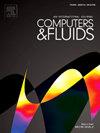Multi-fidelity modeling of net power savings of an actuated turbulent boundary layer
IF 3
3区 工程技术
Q3 COMPUTER SCIENCE, INTERDISCIPLINARY APPLICATIONS
引用次数: 0
Abstract
We simulate and model the net power savings of an actuated turbulent boundary layer flow. The actuation is performed by spanwise traveling transverse surface waves parametrized by wavelength, amplitude, and period. The data is provided by 81 large-eddy simulations (LES) over a range of conditions. Since the numerical resolution of the skin-friction physics requires expensive large-eddy simulations, additional input power data is provided by low-cost, low-fidelity, two-dimensional simulations. An ad-hoc Gaussian Process (GP) framework is used to construct a single and a multi-fidelity surrogate model of the net power savings response to a range of actuation settings. The multi-fidelity model is shown to be able to leverage the two databases and combine the two independent constitutive models for the drag reduction and the input power. The predictive performance of the model is evaluated and compared to the single-fidelity baseline through cross-validated accuracy scores, including its probabilistic predictions. The models are queried to infer the detailed dependence of the flow response on the control parameters, to explore the existence of maxima, and to discuss the physical underpinnings of the flow.
驱动湍流边界层净功率节约的多保真度建模
我们模拟和模拟了驱动湍流边界层流动的净功率节约。驱动是由波长、振幅和周期参数化的横向传播表面波来完成的。这些数据由81个大涡模拟(LES)在一系列条件下提供。由于表面摩擦物理的数值分辨率需要昂贵的大涡模拟,额外的输入功率数据由低成本、低保真度的二维模拟提供。使用一个特别的高斯过程(GP)框架来构建对一系列驱动设置的净节能响应的单保真度和多保真度代理模型。多保真度模型能够利用两个数据库,并结合两个独立的本构模型来减少阻力和输入功率。通过交叉验证的准确性分数,包括其概率预测,评估模型的预测性能,并将其与单保真基线进行比较。对这些模型进行查询,以推断流动响应与控制参数的详细依赖关系,探索最大值的存在性,并讨论流动的物理基础。
本文章由计算机程序翻译,如有差异,请以英文原文为准。
求助全文
约1分钟内获得全文
求助全文
来源期刊

Computers & Fluids
物理-计算机:跨学科应用
CiteScore
5.30
自引率
7.10%
发文量
242
审稿时长
10.8 months
期刊介绍:
Computers & Fluids is multidisciplinary. The term ''fluid'' is interpreted in the broadest sense. Hydro- and aerodynamics, high-speed and physical gas dynamics, turbulence and flow stability, multiphase flow, rheology, tribology and fluid-structure interaction are all of interest, provided that computer technique plays a significant role in the associated studies or design methodology.
 求助内容:
求助内容: 应助结果提醒方式:
应助结果提醒方式:


